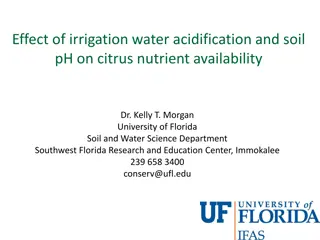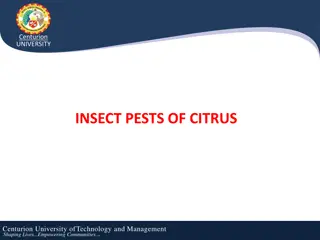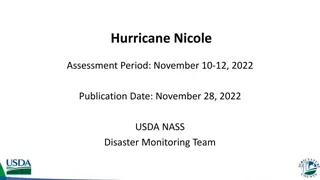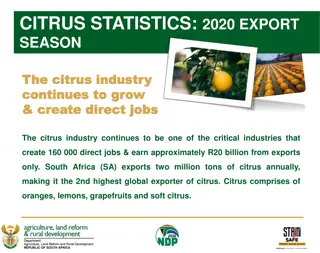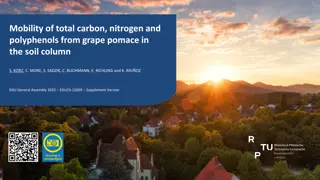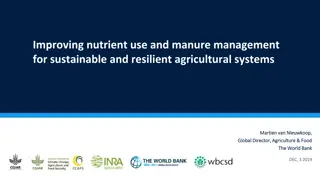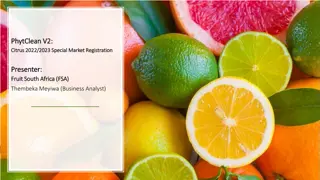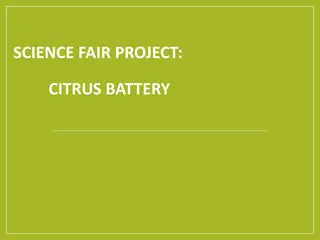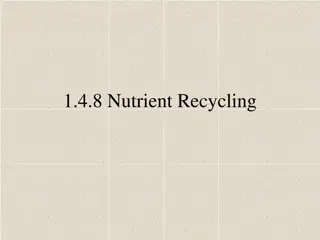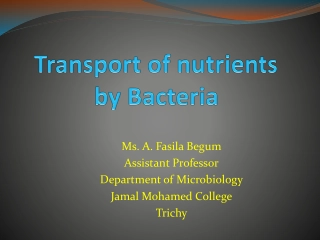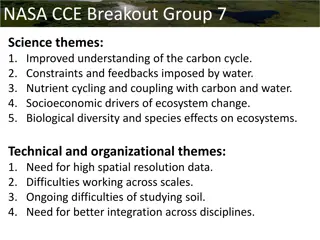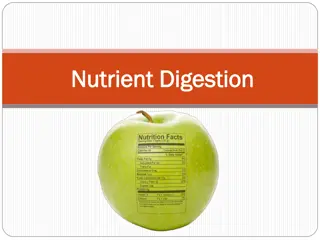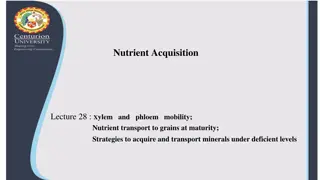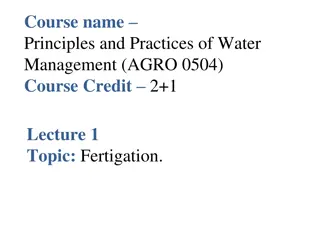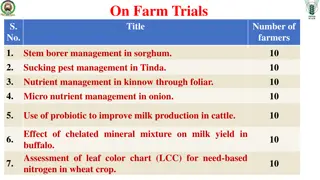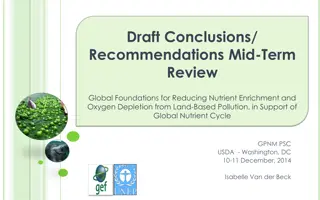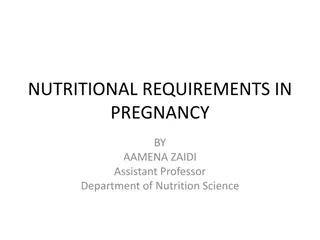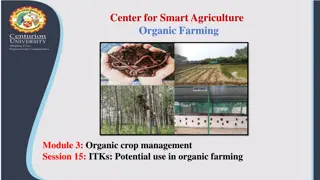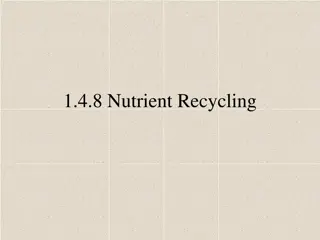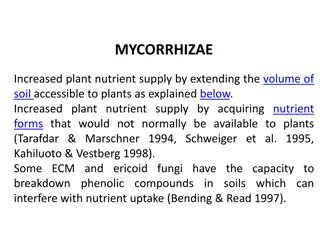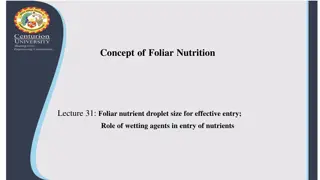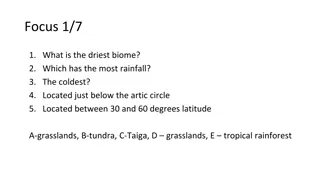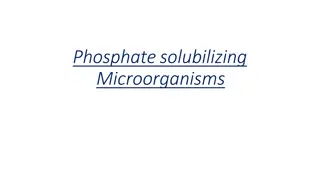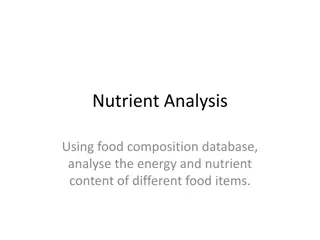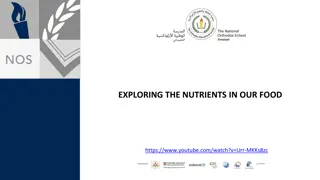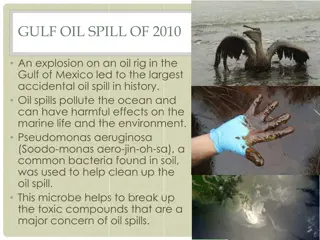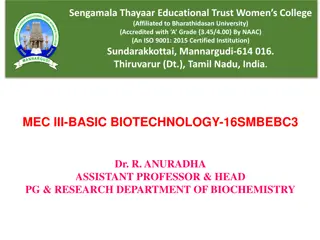Citrus Research and Development Foundation Nutrient Summary
The Citrus Research and Development Foundation (CRDF) in Lake Alfred, FL, conducted research on nutrient management and Huanglongbing (HLB) in citrus trees. Various studies focused on nutrition, root health, vector control, and tree productivity to combat citrus disease. Analysis of foliar ENP application on Ruby Red grapefruit trees showed no significant impact on canopy volume, yield, or fruit size. Leaf element concentrations were also monitored for grapefruit trees during the seasons of 2014-2016.
Download Presentation

Please find below an Image/Link to download the presentation.
The content on the website is provided AS IS for your information and personal use only. It may not be sold, licensed, or shared on other websites without obtaining consent from the author. Download presentation by click this link. If you encounter any issues during the download, it is possible that the publisher has removed the file from their server.
E N D
Presentation Transcript
Citrus Research and Development Foundation, Inc. CPDC Nutrient / HLB Summary Jim Syvertsen , CRDF Horticulture Project Manager 700 Experiment Station Road Lake Alfred FL 33850 citrusrdf.org
CRDF Nutrition / HLB Summary Gruber, Barrit Boman, Brian Wright, Alan 1: Newly planted red GF trees-- Foliar EN & HLB 2: Mature trees-- EN Supplemental fertilizer, HLB, fruit drop ACP & postharvest storage UF Nutrition for IR GF for HLB, fruit drop, postharvest fruit storage 7/1/2014 9/1/2016 $360,000 1: nutritional practices to maintain the productivity of groves. England, Gary Total UF Mid Florida Citrus Foundation grove 10/1/2012 9/30/2015 237,500 UFPhytophthora, Calcium carbonate reductions root health 3: HLB roots, Phytophthora, phosphite, high carbonate well water + acidification, rootstocks and root health Graham, Jim Total 7/1/2012 3/31/2016 942,409 3: Rootstocks & constant optimal nutrition, TigerSul manganese and slow release sodium borate overdoses (combinations, delivery, economics) Grosser, Jude Total UF Rootstocks, HLB, Nutrition 4/1/2012 9/30/2018 684,326 1: HLB, calcium bicarbonate, soil pH & nutrient uptake, water use, root density Morgan, Kelly Total UF Calcium bicarbonate, acid + S and HLB 5/1/2014 4/30/2017 349,491 UFOptimizing ground & foliar nutrients; vector control 2: HLB nutritional sprays, SARs, and aggressive psyllid control program Rouse, Bob Total 4/1/2010 6/30/2014 925,659 7: HLB, ACPS, nutrition, B, tree productivity, mitigation with EN, root efficiency Schumann, Arnold UF Nutrition, tree performance, roots 5/1/2010 6/30/2018 1,609,205 4: Vector control, ACP management , foliar nutrients, mulch, cost/benefit Stansly, Phil Total UF HLB, Nutritional and Insecticidal 7/1/2010 2/14/2016 948,465 Total $ 6,057,055
Bomans foliar ENP Well fertilized 6 yr-old Ruby Red / SO at 160 # N etc. (all sufficient) Units per tree - 2016 4 trees/ trt x 5 reps Percentage change compared to control Fruit size Fruit size Treatment Yield Treatment Yield Small Small Foliar ENP Med. Large Box/Tr Foliar ENP Med. Large Box/Tr Control KP+M Ca KN+KP+M KN+KP+M+Ca DKP+KP+M KN+KP DKP+KP KN+M DKP+M p -value 90 113 93 103 103 102 105 102 119 82 0.704 109 168 115 144 133 155 150 125 133 127 0.405 41 63 38 36 48 60 45 41 41 56 3.3 4.8 3.3 3.8 3.9 4.3 4.1 3.7 4.1 3.8 Control KP+M Ca KN+KP+M KN+KP+M+Ca DKP+KP+M KN+KP DKP+KP KN+M DKP+M 0 26 3 14 14 13 17 13 31 -9 0 53 5 32 22 42 37 14 21 16 0 55 -7 -12 17 48 11 1 0 36 0 47 1 16 20 32 26 14 24 14 0.217 0.305 NS KP Potassium phosphite M Micronutrients KN Potassium nitrate Ca Calcium nitrate (soil) DKP Dipotassium phosphate No significant effect of ENP on Canopy Volume, LAI, Yield or fruit size Importance of P phosphite (KP) and Dipot. phosphate (DKP) Economic analyses
Boman Average concentrations of macro and microelements in leaves of grapefruit trees for the seasons 2014-2016. Sampling Date N P K Ca Mg % % % % % Fe mg/kg mg/kg mg/kg mg/kg mg/kg Cu Mn Zn B Jul 2016 2.47 0.12 1.31 4.23 0.22 56 89 57 35 204
6 yr-old Ruby Red red grapefruit (Citrus paradisi) on Sour Orange (Citrus x aurantium) rootstock. Well fertilized. despite these positives results for most variables evaluated, significant differences were not observed due to high variability in the field Dipotassium poly phosphate (DKP) + low biuret urea (4N-20P-22K) applied at 19L/ha. The research results suggest that treatments KP + Micros, DKP (dipotassium mono and diphosphate)+KP+M and KN+KP showed increases in number of fruit per tree as well as increases in the production of medium and large size fruit. The calcium nitrate applied to the soil had low impact on yield. According to the results, the most relevant components appear to be potassium phosphite (which is present in the treatments with the best results) accompanied by applications of micronutrients and a source of nitrogen (especially DKP).
Nutrient Study Results on HLB Affected Trees Update Kelly T. Morgan March 24, 2017 Irrigation studies 1) Evapotranspiration (ET) models are as effective as soil moisture sensors 2) Higher average water content in blocks irrigated daily, with significantly lower fruit drop. 3) However, no significant increase in yield was found. 4) Two-year greenhouse study (2013 to 2015) using individual lysimeters i) water use in trees are proportional to ET rates, ii) Hamlin and Valencia trees use similar amounts of water, iii)HLB affected trees use 25% less water than healthy trees resulting reduced water uptake by HLB affected trees were proportional to reduction in tree leaf area.
Morgan Nutrient uptake studies Field studies on foliar applications and lowering soil pH positive response in HLB affected trees. 1) Five-year study of foliar micronutrient applications (2010 to 2015) on HLB affected trees was conducted in a commercial grove using three rates on Mn, Zn and B with and without KNO3. This study included a zero nutrient spray application treatment. 2) Similar relationships were found among K, Mn and Zn applications. Leaf Mn and Zn concentrations were below optimum for the control throughout the five years. Treatments of Mn, Zn and B were based on 1.5, 3.0 and 6.0 times IFAS recommendation application rates (prior to HLB). Leaf Mn, Zn and B concentrations increased significantly after application. 3.0 and 6.0 times IFAS recommendations increased tree canopy size and yield but only the 3.0 times IFAS recommendation was significantly greater than the 1.5 and 6.0 time IFAS rate. These results indicate foliar applications of nutrients greater than 3.0 times IFAS promotes increase in canopy volume at the expense of increased fruit yield No increase in canopy volume or yield Increased with leaf B. 3) A two-year greenhouse study from 2015 to 2017. Calcium bicarbonate significantly reduced root densities, leaf area and water uptake (10-15%) of healthy trees but not as much as HLB affected trees (>20%). 4) A three-year study (2014 to 2017) on irrigation water acidification (pH, 7.5, 6.0, 5.0 and 4.0) + sulfur (Tiger 90). Average mature leaf Ca, Mg , Zn, Fe, Mn, and B concentrations increased in the spring 2016 samples. These results may indicate increased nutrient uptake from soils below pH 6.5 5) Leaf samples collected at both sites in June to September indicated no significant differences among treatments. Root density samples taken in February to June indicate a significantly greater root length density from soil pH 7 to 5. Leaf Ca, Mg, Mn, and Zn in November samples were greater for trees treated with sulfur.
Schumann in progress Our main goal is to find the reasons for inconsistent responses of HLB-affected citrus to EN programs and to develop feasible and economical remedies that can consistently replicate successful HLB mitigation with ENs in all Florida groves. 1) Establish nutrient sufficiency guidelines from a very large database of leaf nutrients, tree attributes, soil properties, qPCR, and leaf starch concentrations, across 11 sampling sites in Polk Co. For example, little leaf syndrome on HLB-affected trees related to leaf Mg and Ca (**). Derive the best causal relationships between leaf nutrients and other site factors such as soil, and tree performance despite HLB. 2) The 2nd objective: Determine soil conditions that favor root hair and VAM proliferation of citrus roots, thus maximizing root-uptake of calcium and other deficient nutrients in HLB- affected citrus trees. Liquid aeroponic conditions.
SL253.04: Soil and Leaf Tissue Testing for Commercial Citrus Production Figure 2. Changes in concentration of N, P, K, Ca, and Mg in citrus leaves with age. The shaded areas denote the recommended sampling period and the optimum concentration range for each element.
Table 2. Guidelines for interpreting orange tree leaf analysis based on four- to six-month-old spring flush leaves from nonfruiting twigs (Koo et al. 1984). Unit of measure Element Deficient Low Optimum High Excess N % < 2.2 2.2 2.4 2.5 2.7 2.8 3.0 > 3.0 P % < 0.09 .09 0.11 0.12 0.16 .17 0.30 > 0.30 K % < 0.7 0.7 1.1 1.2 1.7 1.8 2.4 > 2.4 Ca % < 1.5 1.5 2.9 3.0 4.9 5.0 7.0 > 7.0 Mg % < 0.20 .20 0.29 0.30 0.49 .50 0.70 > 0.70 Cl % --- --- < 0.20 .20 0.70 > 0.70 Na % --- --- --- .15 0.25 > 0.25 mg/kg or ppm2 Mn < 18 18 24 25 100 101 300 > 300 Zn mg/kg or ppm < 18 18 24 25 100 101 300 > 300 Cu mg/kg or ppm < 3 3 4 5 16 17 20 > 20 Fe mg/kg or ppm < 35 35 59 60 120 121 200 > 200 B mg/kg or ppm < 20 20 35 36 100 101 200 > 200 Mo mg/kg or ppm < 0.06 .06 0.09 0.10 2.0 2.0 5.0 > 5.0


